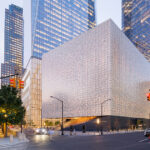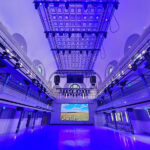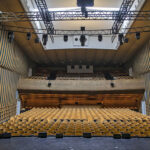Elvis is definitely in the building, and it's a building literally built for a king.
Cirque du Soleil, in partnership with Elvis Presley Enterprises and MGM/Mirage, has Viva ELVIS happening at the new Aria Resort & Casino at CityCenter in Las Vegas, the world''s largest hotel to achieve a Leadership in Energy and Environment Design (LEED) Gold rating from the U.S. Green Building Council. Those expecting a "traditional" Cirque show (if such an animal even exists), or one that mimics their last smash hit, the Beatles-themed LOVE, went home dazzled by the unexpected.
The goal was a harmonious fusion of dance, acrobatics and a new emphasis on live music that would be a suitable tribute for not only one who was (arguably) the King of Rock ‘n' Roll but (less arguably) Las Vegas' King.
The creative challenge was daunting.
"We didn't want to repeat, that's for sure," says Armand Thomas, director of creation. "So we started off looking at the theatre itself, and steered away from it being in the round like LOVE." They also wanted to distance themselves from the use of characters within a song.
Thomas has been with Cirque since 1996. "I joined them on the touring show of Quidam, and 14 years of having a big mouth and lots of opinions" lead to his current position, jokes Thomas, who worked his way up, from handling technical duties to general stage manager, production manager, then assistant director/creator, to his current position. "This is my first time as creator," he notes.
Throwing Darts
Thirty of Elvis' songs are used in the production, and like the Beatle's LOVE, there are contemporary remixes. Elvis' voice is the only male singing voice, joined occasionally by live female singers. The show has a 76-person cast, including dancers, musicians, singers and acrobats.
As with LOVE, the music came first: "The traditional Cirque way is to create an act, then fill in the song," Thomas explains. "But with these big iconic songs, we did the reverse."
Narrowing down the list of Elvis' songs was easy at first. "In the Elvis collection there are at least 750 songs and you can easily toss out 600 immediately," Thomas says. Choosing the final 30 songs, however, proved to be an unenviable task. (Not all are performed in their original length.)
As if building a Cirque show wasn't complicated enough, the "to do" list for Viva ELVIS! started with the need for the Elvis Theater, built from the ground up. It was designed by Johnny Boivin, Cirque's creation director, under the direction of Gilles Ste-Croix, Cirque's vice president of creation/new project development. They began with a commitment to a conventional proscenium layout.
"It was always Gilles' ambition to create an ‘opera' style show with large set pieces, and the back stage and below stage storage areas were planned with that in mind," set designer Mark Fisher says. "The set pieces that I designed were all made to fit the building, and everything worked quite smoothly."
Although Thomas notes that "we were at the mercy of how building progressed at the Aria," he adds there was also a great deal of flexibility – and the need to proceed with caution.
"They were asking what we wanted – what kind of stage lift, what kind of scenic elements we'd have, what the rig would be comprised of," Thomas says. "All this time we're also listening to music. So we had to throw darts at the ideas. In the end we had to put water in our wine and go with a stage that was a little more utilitarian so that if we did change our mind on something we weren't tied to that very special lift that was really just for that one idea that has since been thrown out. So the stage components are a little more traditional and malleable."
Along with Cirque du Soleil, others collaborating on the design of the 1,840-seat theatre included Auerbach Pollock Frielander, the MGM Mirage Design Group, and architects Pelli Clarke Pelli, Gensler, and HKS, Inc. The result: It features one of the largest proscenium stages in North America, with a proscenium spanning 80 feet in width and 50 feet in height.
Video plays a big part in the show. There are six projectors and an LED wall made up of eight 30-foot-by-40-foot columns. The stage measures 20,000 square feet, and the grid overhead is 104 feet in height.
The designers ended up asking for, and getting, 17 lifts, which Thomas described as "pretty versatile, and they can be used in a variety of ways. So if you suddenly had a brilliant idea at the end you could still incorporate it in the show." One of the lifts has a capacity of 27,000 pounds.
Fisher "merely" designed the scenery to fit the building. "But it was not designed to leave much empty space," he says. "The technical crews have to work very hard, but the show ran quite smoothly from the start."
First, the Music
"The music dictated the first steps, and then we brought set designer Mark Fisher in," Thomas explains. "There were roundtable creative meetings with him, director/writer Vincent Paterson, and Mike Anderson, the production manager. Also key were the acrobatic boys, Daniel Cola (acrobatic performance designer) and Guy St-Amour (acrobatic equipment and rigging designer)."
Developing the show began with a series of questions about what was on the shelf, what the individual creative designers always wanted to do, and what was "hot" at the moment. "It's a lot of tossing out ideas – roller skates? Tramps? Russian bears? And what does that have to do with Elvis? You have to know how to use those elements and still be a very dance-oriented show." Acrobatics are not as prominently featured, but interwoven into the narrative. "We decided early on that dance would be the heartbeat of the show, with acrobatics complementing that."
The process of "throwing darts" led to some audacious set pieces, including a giant guitar that opens the show. "We thought, we could have this enormous guitar and have acro street parkour, the latest craze, which is very European and basically street running." Big set pieces were key to bringing Elvis to life: "We couldn't afford to put little [set pieces] on the side because it would underplay Elvis' importance." That's fine, but where to put these big pieces when they weren't on stage? Despite the theatre's huge backstage area, every square inch was occupied. And the weight requirements? The four-story jail weighs 90,000 pounds, yet it is flown in and out from backstage using a track and trolley system.
Fisher got his start with Cirque du Soliel with KÀ, where he helped design both the permanent theatre and the technically-complex sets. He says the biggest difference between designing a rock show and a Cirque show is that with the former, the scenery is more of a background while in the latter it's part of the landscape in which the performers live and move to create their show.
"The music of Elvis has been in the background of my life since I was at school," Fisher notes. "I visited Graceland in the 1980s when I worked on a proposal for a touring Elvis exhibition, and again, when I measured up the gates for the Las Vegas production of We Will Rock You. So I had some background with Elvis memorabilia before the project started. When I was asked to work on Viva ELVIS, I researched his shows, his films, and his home life in greater depth.
"In Viva ELVIS, the line between the scenery elements and the acrobatic equipment is sometimes blurred," Fisher continues. "And that was a deliberate choice. Elvis has transcended reality and become a mythic figure, so his reappearance in Las Vegas must be done with a scale and opulence that reflects his status."
Another whopper of a scenic element was the blue suede shoe, which itself evolved. "Originally it was a comic prop. Later it became an acrobatic prop with a slide, parallel-bar laces and a trampoline." While he designed the early version, the version in the show was ultimately designed by Cola and built by Michael Curry. It weighs 1,500 pounds and it measures almost 30 feet in length.
If Fisher wasn't exactly working on a shoestring budget, the expansive production still needed to meet strict budgetary guidelines. "Vincent's vision of the show was for a multiplicity of different scenes," Fisher notes. "It was challenging to create the number and variety of scenic looks that he wrote into his book."
Summing up, Fisher says he was especially pleased both the trampoline set for "Gotta Lotta Livin' to Do" and the "Jailhouse Rock" set. "In their different ways they are both complex pieces of engineering that allow large scale acrobatic performance."
Icing on the Cake
Viva ELVIS! was the first Cirque du Soleil production for award-winning lighting designer Marc Brickman. He was brought into the process in March of 2006, and says he was "very humbled" by the team's creative process.
"I tried to provide the icing on the cake," he says. "After all these incredible, creative ideas from the core team evolved, and the sheer energy the show was going to have, I wanted to design something that would illuminate that." He adds that during the process, he had to be ready to change his design at a moment's notice, "which happens when you're around such creative people."
The size of the set pieces proved challenging. "The shoe set piece is just enormous – staggering in size," Brickman says. "I was just in awe of all the set pieces." But the shoe itself proved challenging to light. Changes that were made right before opening didn't allow him to put lights inside. "That was just the nature of the beast," he says. "So we just went ahead and made it work."
Otherwise, "a lot of the lighting of it ended up being determined by the acrobats. We needed to see everywhere behind them, and at the end of the day, what they were doing on and around the shoe determined how it was lit."
Brickman is very matter-of-fact about his contributions to the show: "The lighting isn't what people remember. It's there to illuminate all the talent, the set design, the world-class production design, all of it. Lighting is just polishing the hubcaps."
But Brickman calls Viva ELVIS! "four years of my life well-spent," and his contribution to the production hasn't gone unnoticed. "Marc was brilliant with creating the atmosphere," Thomas says. "He provided the show with a lot of rich moods."
Pyro and Effects
One of the more dazzling moments involves a waterfall/pyro effect at the very top of the show that frames a big photo of the King on a video wall. Pyro appears also at the end of the big "Blue Suede Shoes" number,
during a campfire scene, and then again for the big finale. All of this was the work of Advanced Entertainment Services (AES), adding pyrotechnic touches to this latest Cirque du Soleil show.
AES's Matt Dillingham worked closely with the Cirque creative team lead by Martin Gauthier, Michel Tremblay, and Karl Seymour to develop the pyrotechnic and gas flame effects. "They needed wireless control for the pyro and gas system, so we had to customize a control system to accommodate that," Dillingham explains. "But working with such a great crew and a nice working environment made that go smoothly.
He says it was necessary to develop a custom wireless control system for the flame effects in the statues which would accommodate the movement during the performance and provide multiple redundant control features required to operate the system safely. "The collaboration between AES, Sigma Services, and Doug Fleenor Design was essential in accomplishing that challenge."
Dillingham says their 2005 show, KÀ, used significant amounts of pyro, and they've continued that trend through to Elvis. "What pyro there is in this show is very tastefully done. It all has a purpose. Some shows throw it in for the sake of having it, but there's always a good reason for it to be in a Cirque show."
AES supplied Ultratec ground fog machines and MGD smoke and haze machines. Ultratec and RES Specialty Pyrotechnics also contributed to the collection of effects.
Other Highlights
An acrobatic and scenic special effect that has people talking is the "Jailhouse Rock" number. The set was provided by Stageline Mobile Stages, and it's four stories of immenseness. It weighs 90,000 pounds and measures 39 feet tall by 66 feet wide by 45 feet deep. Oh, and did we mention that the dancers can dance right side up or upside down?
It rolls in under control of an automated system. "This structure also had to move on the stage at two feet per second on 462 wheels in silence," says Guy St-Amour, acrobatic equipment and rigging designer for Cirque. "The (automation) of that structure was made by Stage Technologies with six drive motors that can move 15,000 pounds each."
Visually, the "inverted walk" is stunning; cops and robbers running and dancing, back and forth, upside and downside. Dancers in harnesses make it all happen with ease to great effect. "We decided to work with Stageline because of the company's capacity to build such an unconventional structure," says St-Amour.
Stageline Mobile Stage's president Yvan Miron says he has worked on a few Cirque projects before, but his relationship with St-Amour goes back on the way to 1987 when St-Amour was involved in another Cirque show. "The biggest challenge was what [set designer] Mark Fisher actually wanted," Miron says. "It was going to be a huge set, yet it needed to be extremely light. Also, the time frame was an issue, especially as [Cirque] is well-known for always perfecting their shows, and that means they'd be changes up to the last minute!" he laughs. "Everything with them is a work in progress until the very end."
The Las Vegas set was engineered and constructed by ShowFX. It is an 80-foot-wide by 45-foot-deep tri-level set including an automated retracting grand staircase and integrated electro-mechanical performer lift in the upper level. The set is the centerpiece for the grand finale. But that's not all they did.
"With four weeks to opening performance, Cirque called upon ShowFX to build the Juke Box," says David Mendoza of ShowFX. "Following a Las Vegas briefing with the Cirque team and [set designer] Mark Fisher, the ShowFX team went back to LA and proceeded to engineer, fabricate, ship, and install the Juke Box in record time. We ran 12-hour shifts for three weeks in the shop and double shifts for three days in Las Vegas to install. It was many a long day and many a tired crew, but it was all worth it when Mark Fisher called to personally thank me and say how pleased he was with the finished set."
Video has long been an important element in a Cirque show, and arguably, it was more important than ever because so much of Elvis' persona was derived from his movies and TV specials, parts of which were shown as part of the live show. The show uses a 30-foot 8-inch high by 40-foot wide video display comprised of 64 Daktronics PST-12i modular LED video panels. The display is broken out into eight columns that measure approximately 30 feet, 8 inches in height by 5 feet in width. These can be raised, lowered, and moved side to side offering various display configurations throughout the show.
The modular video panels are thin and lightweight, which is advantageous especially for projects that have space and weight limitations. They are also fanless, which ensures that the only thing spectators hear is the show itself.
The rigging blocks were supplied by J.R. Clancy, Inc. Vice president of marketing, Tom Young, says, "Perhaps not the most glamorous part of the project, but a key part of the system!"
Viva ELVIS! by Cirque du Soleil
Gear
110 Vari*Lite VL 3500 Wash FX fixtures
28 Vari*Lite VL 3000 Spot fixtures
67 Vari*Lite VL 3500 Spot fixtures
26 Syncrolite MX4s
170 Elation Tri PARs
24 Pulsar Chroma Floods
26 Martin Atomic 3K strobes w/ scrollers
36 Solaris Quasar 15K strobes
1 Solaris T-Light 85K strobe
25 T8 Technologies Luma Panels
6 Robert Juliat Cyrano 2.5K followspots
2 Clay Paky Alpha Spot 700 HPEs
50 ETC Source Four PARs
25 ETC Source Four Lekos w/ 26° lens
10 ETC Source Four Lekos w/ 36° lens
15 ETC Source Four Lekos w/ 50° lens
25 Thomas PAR20s
30 Altman StarPAR CDMs
75 Altman PAR64s
154 Altman Snub Nose PAR64
2 MA Lighting grandMA Consoles
2 MA Lighting grandMA Light Consoles
2 MA Lighting grandMA Replays
10 MA Lighting grandMA Nodes
4 Hewlett Packard iPAQ handheld remote
3 Wireless Solutions W-DMX Blackbox S2000 transmitters
14 Wireless Solutions W-DMX Blackbox R512 micro receivers
10 ETC Sensor Plus 48-module advanced feature rack
18 ETC Smart Switch 48
60 ETC Net3 2port portable gateway
4 ETC Net3 4port gateways
2 Crestron Pro2 processors
1 Crestron CNXRMAK
2 Crestron wireless touch panel
2 Crestron 12" touch panel


